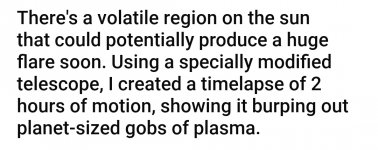Space Thread
- Thread starter B00Mer
- Start date
You are using an out of date browser. It may not display this or other websites correctly.
You should upgrade or use an alternative browser.
You should upgrade or use an alternative browser.
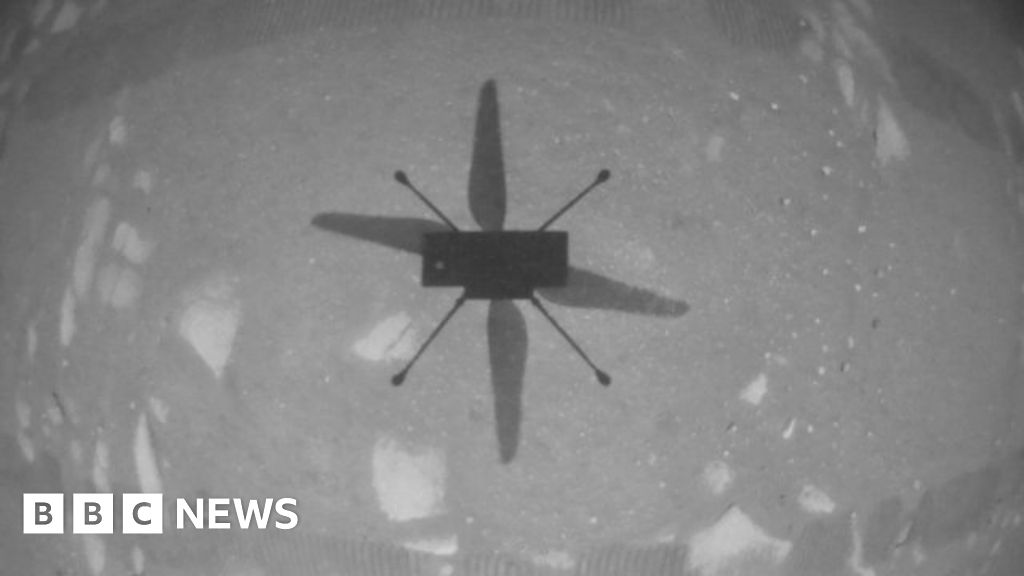
Nasa successfully flies small helicopter on Mars
The Ingenuity drone completes the first powered, controlled flight by an aircraft on another world.
Nasa's Rover makes breathable oxygen on Mars
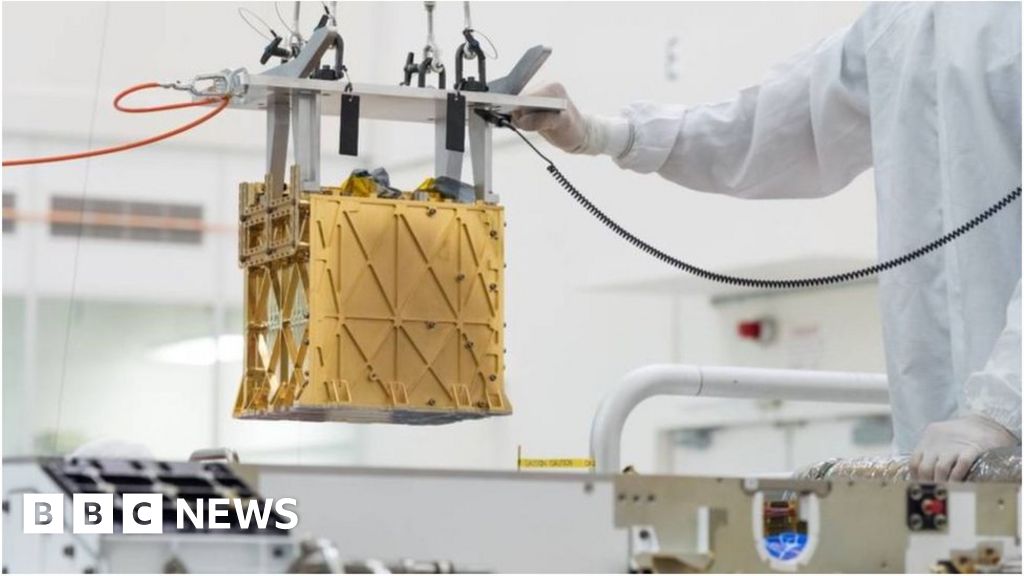
 www.bbc.com
www.bbc.com

Nasa's rover makes breathable oxygen on Mars
An instrument in the Perseverance rover produces oxygen from the planet's carbon dioxide atmosphere.
A black hole dubbed 'the Unicorn' may be galaxy's smallest one
Author of the article:Reuters
Reuters
Will Dunham
Publishing date:Apr 22, 2021 • 1 day ago • 3 minute read • Join the conversation
A black hole located approximately 1,500 light years from our solar system, discovered in the constellation Monoceros, pulls at a nearby red giant star, distorting its light in an undated illustration.
A black hole located approximately 1,500 light years from our solar system, discovered in the constellation Monoceros, pulls at a nearby red giant star, distorting its light in an undated illustration. PHOTO BY OHIO STATE ILLUSTRATION/LAUREN F /via REUTERS
Article content
WASHINGTON — Scientists have discovered what may be the smallest-known black hole in the Milky Way galaxy and the closest to our solar system – an object so curious that they nicknamed it ‘the Unicorn.’
The researchers said the black hole is roughly three times the mass of our sun, testing the lower limits of size for these extraordinarily dense objects that possess gravitational pulls so strong not even light can escape. A luminous star called a red giant orbits with the black hole in a so-called binary star system named V723 Mon.
The black hole is located about 1,500 light years – the distance light travels in a year, 5.9 trillion miles (9.5 trillion km) – from Earth. While it may be the closest one to us, it is still far away. By way of comparison, the closest star to our solar system, Proxima Centauri, is 4 light years away.
Black holes like this one form when massive stars die and their cores collapse.
Advertisement
STORY CONTINUES BELOW
This advertisement has not loaded yet, but your article continues below.
Article content
“We nicknamed this black hole ‘the Unicorn’ partly because V723 Mon is in the Monoceros constellation – which translates to unicorn – and partly because it is a very unique system” in terms of the black hole’s mass and relative closeness to Earth, said Ohio State University astronomy doctoral student Tharindu Jayasinghe, lead author of the study published this week in the journal Monthly Notices of the Royal Astronomical Society.
There are three categories of black holes. The smallest, like ‘the Unicorn,’ are so-called stellar mass black holes formed by the gravitational collapse of a single star. There are gargantuan ‘supermassive’ black holes like the one at our galaxy’s center, 26,000 light years from Earth, which is four million times the sun’s mass. A few intermediate-mass black holes also have been found with masses somewhere in between.
“It is clear that nature makes black holes of a wide range of masses. But a three-solar-mass black hole is a big surprise. There are no very good models for how to make such a black hole, but I am sure people will work on that more now,” said Ohio State University astronomy professor and study co-author Kris Stanek.
‘The Unicorn’ falls into what the researchers called a “mass gap” between the largest-known neutron stars – objects similarly formed by a large star’s collapse – at around 2.2 times the mass of our sun and what previously had been considered the smallest black holes at around five times the sun’s mass.
Advertisement
STORY CONTINUES BELOW
This advertisement has not loaded yet, but your article continues below.
Article content
“‘The unicorn’ is truly one of the smallest black holes possible,” Jayasinghe said.
Its strong gravity alters the shape of its companion star in a phenomenon known as tidal distortion, making it elongated rather than spherical and causing its light to change as it moves along its orbital path. It was these effects on the companion star, observed using Earth-based and orbiting telescopes, that indicated the black hole’s presence.
“Black holes are electromagnetically dark, and so they are difficult to find,” Jayasinghe said.
Unlike some other black holes orbiting with a star, this one was not observed to be drawing material from its companion, which is 173 times more luminous than our sun.
The only smaller potential black hole is one with a mass 2.6 times that of our sun that was spotted in another galaxy, Jayasinghe said.
Another team of scientists last year described a black hole roughly 1,000 light years from Earth, but other researchers have questioned whether it is a black hole.

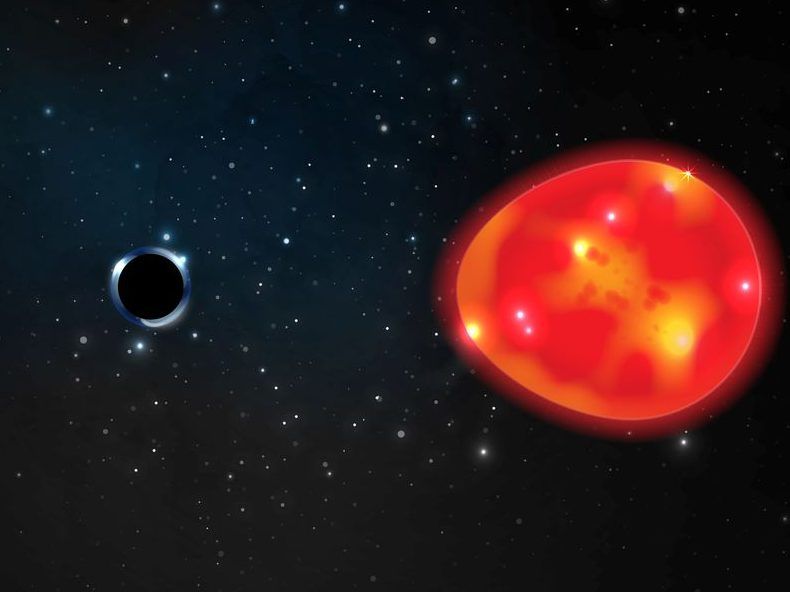
 torontosun.com
torontosun.com
Author of the article:Reuters
Reuters
Will Dunham
Publishing date:Apr 22, 2021 • 1 day ago • 3 minute read • Join the conversation
A black hole located approximately 1,500 light years from our solar system, discovered in the constellation Monoceros, pulls at a nearby red giant star, distorting its light in an undated illustration.
A black hole located approximately 1,500 light years from our solar system, discovered in the constellation Monoceros, pulls at a nearby red giant star, distorting its light in an undated illustration. PHOTO BY OHIO STATE ILLUSTRATION/LAUREN F /via REUTERS
Article content
WASHINGTON — Scientists have discovered what may be the smallest-known black hole in the Milky Way galaxy and the closest to our solar system – an object so curious that they nicknamed it ‘the Unicorn.’
The researchers said the black hole is roughly three times the mass of our sun, testing the lower limits of size for these extraordinarily dense objects that possess gravitational pulls so strong not even light can escape. A luminous star called a red giant orbits with the black hole in a so-called binary star system named V723 Mon.
The black hole is located about 1,500 light years – the distance light travels in a year, 5.9 trillion miles (9.5 trillion km) – from Earth. While it may be the closest one to us, it is still far away. By way of comparison, the closest star to our solar system, Proxima Centauri, is 4 light years away.
Black holes like this one form when massive stars die and their cores collapse.
Advertisement
STORY CONTINUES BELOW
This advertisement has not loaded yet, but your article continues below.
Article content
“We nicknamed this black hole ‘the Unicorn’ partly because V723 Mon is in the Monoceros constellation – which translates to unicorn – and partly because it is a very unique system” in terms of the black hole’s mass and relative closeness to Earth, said Ohio State University astronomy doctoral student Tharindu Jayasinghe, lead author of the study published this week in the journal Monthly Notices of the Royal Astronomical Society.
There are three categories of black holes. The smallest, like ‘the Unicorn,’ are so-called stellar mass black holes formed by the gravitational collapse of a single star. There are gargantuan ‘supermassive’ black holes like the one at our galaxy’s center, 26,000 light years from Earth, which is four million times the sun’s mass. A few intermediate-mass black holes also have been found with masses somewhere in between.
“It is clear that nature makes black holes of a wide range of masses. But a three-solar-mass black hole is a big surprise. There are no very good models for how to make such a black hole, but I am sure people will work on that more now,” said Ohio State University astronomy professor and study co-author Kris Stanek.
‘The Unicorn’ falls into what the researchers called a “mass gap” between the largest-known neutron stars – objects similarly formed by a large star’s collapse – at around 2.2 times the mass of our sun and what previously had been considered the smallest black holes at around five times the sun’s mass.
Advertisement
STORY CONTINUES BELOW
This advertisement has not loaded yet, but your article continues below.
Article content
“‘The unicorn’ is truly one of the smallest black holes possible,” Jayasinghe said.
Its strong gravity alters the shape of its companion star in a phenomenon known as tidal distortion, making it elongated rather than spherical and causing its light to change as it moves along its orbital path. It was these effects on the companion star, observed using Earth-based and orbiting telescopes, that indicated the black hole’s presence.
“Black holes are electromagnetically dark, and so they are difficult to find,” Jayasinghe said.
Unlike some other black holes orbiting with a star, this one was not observed to be drawing material from its companion, which is 173 times more luminous than our sun.
The only smaller potential black hole is one with a mass 2.6 times that of our sun that was spotted in another galaxy, Jayasinghe said.
Another team of scientists last year described a black hole roughly 1,000 light years from Earth, but other researchers have questioned whether it is a black hole.


A black hole dubbed 'the Unicorn' may be galaxy's smallest one
WASHINGTON — Scientists have discovered what may be the smallest-known black hole in the Milky Way galaxy and the closest to our solar system – an object so curious…
Proliferation of space junk blocking our view of the cosmos, research shows
Author of the article:Washington Post
Washington Post
Christopher Ingraham, The Washington Post
Publishing date:Apr 27, 2021 • 1 day ago • 3 minute read • Join the conversation
A Starlink satellite leaves a streak of light across this image taken on November 2, 2020, by Hubble's Wide Field Camera 3.
A Starlink satellite leaves a streak of light across this image taken on November 2, 2020, by Hubble's Wide Field Camera 3. PHOTO BY NASA /Space Telescope Science Institute
Article content
The rapidly growing cloud of satellites and space junk orbiting the Earth is beginning to block our view of the universe around us, according to new research.
Each individual object in orbit, from the tiniest bits of space garbage to the largest man-made satellites, reflects a commensurate amount of sunlight back toward the earth. Multiplied by the tens of millions, the collective amounts to a 10% increase in illumination across the night sky. That increased sky glow is washing out our view of the cosmos, making it harder for scientists to peer into the farthest reaches of our galaxy and the universe beyond.
If the astronomers’ calculations are correct, it means we’ve surpassed a sky brightness threshold for unimpeded astronomical observation set decades ago by the International Astronomical Union, an association of professional astronomers who, among other things, assign names to newly discovered celestial bodies.
Advertisement
STORY CONTINUES BELOW
This advertisement has not loaded yet, but your article continues below.
Article content
“Since there are objects orbiting the Earth in all manner of orbital inclinations, really nowhere is safe from this,” said John Barentine, director of public policy of the International Dark-Sky Association and a co-author of the study, which was published in the Monthly Notices of the Royal Astronomical Society, a scientific journal.
One major area of concern is the rise of satellite mega-constellations, like SpaceX’s Starlink project, which has put more than 1,300 satellites in orbit since 2018 with plans to potentially launch tens of thousands more. Other companies, including Amazon and OneWeb, also have constellation plans of their own (Amazon CEO Jeff Bezos owns The Washington Post).
Those figures would represent a massive increase over the current number of operational satellites in orbit, which the Union of Concerned Scientists estimates to be more than 3,300. The devices are used in telecommunications, navigation, weather monitoring, space science and other areas.
In addition to satellites, the European Space Agency estimates there are tens of thousands of large pieces of space debris orbiting the earth, a number which swells into the millions when considering smaller objects down to a diameter of 1 millimeter. According to NASA, the debris has a collective mass of about 6,000 tons.
Some of the newer satellites have left glowing streaks through telescope images and prompted enough outcry among astronomers that Starlink has taken steps to reduce their luminosity. But the latest versions are still too bright by “a factor of more than 2,” Barentine said, noting that there is “no clear commitment” from the other commercial satellite operators to adopt the same brightness limit as SpaceX.
Advertisement
STORY CONTINUES BELOW
This advertisement has not loaded yet, but your article continues below.
Article content
But the new research digs into the possibility of astronomical disruption above and beyond individual satellites’ direct effects on images. Every additional orbital object also contributes to an increase in the total luminosity of the light sky, as sunlight reflects off its surface and scatters throughout the atmosphere. The effect is similar to ground-based light pollution from lamps and other nighttime light sources, which effectively wash out the visual contrast of the night sky, making fainter astronomy targets more difficult to see.
It’s also plausible that we could be hampering our ability to detect hazardous asteroids on a collision course with earth. “I think the answer is ‘we don’t know,'” Barentine said, “but the idea that we might miss an object on a collision course with Earth is concerning.”
Christopher Kyba, a light pollution expert at the German Research Center for Geosciences who was not involved in the research, called the results “really shocking” but cautioned that they still need to be confirmed by experimental data.
“The problem with the reflected light from objects humans put into space (if the authors are correct) is that there’s almost nowhere on Earth you could go to avoid it,” Kyba said. “So as more satellites are put into orbit, all of Earth’s countryside and wilderness areas will get brighter.”
Kyba says he’s optimistic that in the coming decades scientists will develop ways to safely remove man-made debris from orbit, which could lessen some of these pressures.
“The night sky is a gift the cosmos gives to all of humanity, inspiring awe and wonder and drawing our thoughts to some of the greatest questions humanity has ever asked in trying to understand the universe,” Barentine said. But, he added, “it’s already under assault in many parts of the world from terrestrial light pollution, and the contribution of diffuse light from satellites and space debris potentially robs us of something that is rightly the shared heritage of all people.”
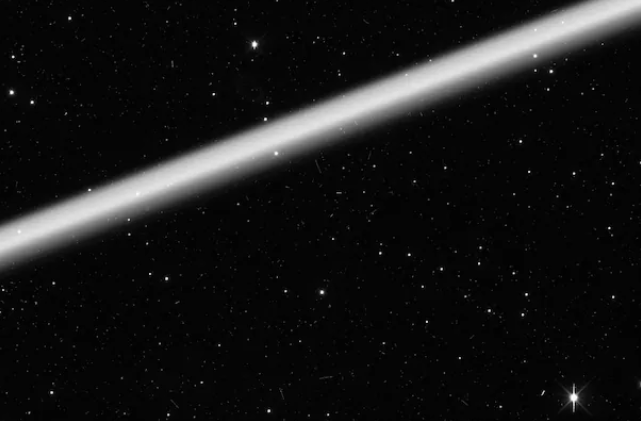
 torontosun.com
torontosun.com
Author of the article:Washington Post
Washington Post
Christopher Ingraham, The Washington Post
Publishing date:Apr 27, 2021 • 1 day ago • 3 minute read • Join the conversation
A Starlink satellite leaves a streak of light across this image taken on November 2, 2020, by Hubble's Wide Field Camera 3.
A Starlink satellite leaves a streak of light across this image taken on November 2, 2020, by Hubble's Wide Field Camera 3. PHOTO BY NASA /Space Telescope Science Institute
Article content
The rapidly growing cloud of satellites and space junk orbiting the Earth is beginning to block our view of the universe around us, according to new research.
Each individual object in orbit, from the tiniest bits of space garbage to the largest man-made satellites, reflects a commensurate amount of sunlight back toward the earth. Multiplied by the tens of millions, the collective amounts to a 10% increase in illumination across the night sky. That increased sky glow is washing out our view of the cosmos, making it harder for scientists to peer into the farthest reaches of our galaxy and the universe beyond.
If the astronomers’ calculations are correct, it means we’ve surpassed a sky brightness threshold for unimpeded astronomical observation set decades ago by the International Astronomical Union, an association of professional astronomers who, among other things, assign names to newly discovered celestial bodies.
Advertisement
STORY CONTINUES BELOW
This advertisement has not loaded yet, but your article continues below.
Article content
“Since there are objects orbiting the Earth in all manner of orbital inclinations, really nowhere is safe from this,” said John Barentine, director of public policy of the International Dark-Sky Association and a co-author of the study, which was published in the Monthly Notices of the Royal Astronomical Society, a scientific journal.
One major area of concern is the rise of satellite mega-constellations, like SpaceX’s Starlink project, which has put more than 1,300 satellites in orbit since 2018 with plans to potentially launch tens of thousands more. Other companies, including Amazon and OneWeb, also have constellation plans of their own (Amazon CEO Jeff Bezos owns The Washington Post).
Those figures would represent a massive increase over the current number of operational satellites in orbit, which the Union of Concerned Scientists estimates to be more than 3,300. The devices are used in telecommunications, navigation, weather monitoring, space science and other areas.
In addition to satellites, the European Space Agency estimates there are tens of thousands of large pieces of space debris orbiting the earth, a number which swells into the millions when considering smaller objects down to a diameter of 1 millimeter. According to NASA, the debris has a collective mass of about 6,000 tons.
Some of the newer satellites have left glowing streaks through telescope images and prompted enough outcry among astronomers that Starlink has taken steps to reduce their luminosity. But the latest versions are still too bright by “a factor of more than 2,” Barentine said, noting that there is “no clear commitment” from the other commercial satellite operators to adopt the same brightness limit as SpaceX.
Advertisement
STORY CONTINUES BELOW
This advertisement has not loaded yet, but your article continues below.
Article content
But the new research digs into the possibility of astronomical disruption above and beyond individual satellites’ direct effects on images. Every additional orbital object also contributes to an increase in the total luminosity of the light sky, as sunlight reflects off its surface and scatters throughout the atmosphere. The effect is similar to ground-based light pollution from lamps and other nighttime light sources, which effectively wash out the visual contrast of the night sky, making fainter astronomy targets more difficult to see.
It’s also plausible that we could be hampering our ability to detect hazardous asteroids on a collision course with earth. “I think the answer is ‘we don’t know,'” Barentine said, “but the idea that we might miss an object on a collision course with Earth is concerning.”
Christopher Kyba, a light pollution expert at the German Research Center for Geosciences who was not involved in the research, called the results “really shocking” but cautioned that they still need to be confirmed by experimental data.
“The problem with the reflected light from objects humans put into space (if the authors are correct) is that there’s almost nowhere on Earth you could go to avoid it,” Kyba said. “So as more satellites are put into orbit, all of Earth’s countryside and wilderness areas will get brighter.”
Kyba says he’s optimistic that in the coming decades scientists will develop ways to safely remove man-made debris from orbit, which could lessen some of these pressures.
“The night sky is a gift the cosmos gives to all of humanity, inspiring awe and wonder and drawing our thoughts to some of the greatest questions humanity has ever asked in trying to understand the universe,” Barentine said. But, he added, “it’s already under assault in many parts of the world from terrestrial light pollution, and the contribution of diffuse light from satellites and space debris potentially robs us of something that is rightly the shared heritage of all people.”

Proliferation of space junk blocking our view of the cosmos, research shows
The rapidly growing cloud of satellites and space junk orbiting the Earth is beginning to block our view of the universe around us, according to new research.
Musk trolls Bezos as space race between world's richest men heats up
Author of the article:Reuters
Reuters
Publishing date:Apr 27, 2021 • 18 hours ago • 2 minute read • Join the conversation
Amazon and Blue Origin founder Jeff Bezos addresses the media about the New Shepard rocket booster and Crew Capsule mockup at the 33rd Space Symposium in Colorado Springs, Colorado, United States April 5, 2017.
Amazon and Blue Origin founder Jeff Bezos addresses the media about the New Shepard rocket booster and Crew Capsule mockup at the 33rd Space Symposium in Colorado Springs, Colorado, United States April 5, 2017. PHOTO BY ISAIAH DOWNING /REUTERS
Article content
The space race between the world’s two richest men went into hyperdrive on Tuesday after Tesla chief Elon Musk took a swipe at Jeff Bezos’ attempt to challenge a major NASA contract.
The two billionaires, who have been trying to launch long-range orbital rockets, were competing for a coveted contract from the government to build a spaceship to deliver astronauts to the moon as early as 2024.
Musk won. Bezos was not happy.
Bezos’ Blue Origin on Monday filed a protest with the Government Accountability Office (GAO), accusing the National Aeronautics and Space Administration (NASA) of moving the goalposts for contract bidders at the last minute.
Musk, who also leads SpaceX, fired back with a tweet that said: “Can’t get it up (to orbit) lol.”
Advertisement
STORY CONTINUES BELOW
This advertisement has not loaded yet, but your article continues below.
Article content
He did not elaborate on the tweet, but pasted a screenshot of a 2019 report about Bezos unveiling Blue Origin’s moon lander on the same Twitter thread.
Blue Origin has fallen far behind SpaceX and United Launch Alliance (ULA) on orbital transportation, losing out on billions of dollars’ worth of U.S. national security launch contracts that begin in 2022. ULA is a joint venture of Boeing Co and Lockheed Martin Corp.
These rocket startups mainly aim to send satellites for clients into orbit at an affordable price and reuse parts of rockets to keep costs in check.
Earlier this month, NASA awarded SpaceX the lunar contract over Blue Origin and defense contractor Dynetics. The sought-after project aims to put humans back on the moon for the first time since 1972.
“NASA has executed a flawed acquisition for the Human Landing System program and moved the goalposts at the last minute,” Blue Origin said in an emailed statement.
“Their decision eliminates opportunities for competition, significantly narrows the supply base, and not only delays, but also endangers America’s return to the moon. Because of that, we’ve filed a protest with the GAO.”
The GAO also confirmed that Dynetics had challenged the NASA contract award to SpaceX. Dynetics did not immediately respond to a Reuters request for comment.
Musk’s SpaceX bid alone while Amazon.com founder Bezos’ Blue Origin partnered with Lockheed Martin Corp, Northrop Grumman Corp and Draper.
The filing of the 50-page protest by Blue Origin was reported earlier by the New York Times.


 torontosun.com
torontosun.com
Author of the article:Reuters
Reuters
Publishing date:Apr 27, 2021 • 18 hours ago • 2 minute read • Join the conversation
Amazon and Blue Origin founder Jeff Bezos addresses the media about the New Shepard rocket booster and Crew Capsule mockup at the 33rd Space Symposium in Colorado Springs, Colorado, United States April 5, 2017.
Amazon and Blue Origin founder Jeff Bezos addresses the media about the New Shepard rocket booster and Crew Capsule mockup at the 33rd Space Symposium in Colorado Springs, Colorado, United States April 5, 2017. PHOTO BY ISAIAH DOWNING /REUTERS
Article content
The space race between the world’s two richest men went into hyperdrive on Tuesday after Tesla chief Elon Musk took a swipe at Jeff Bezos’ attempt to challenge a major NASA contract.
The two billionaires, who have been trying to launch long-range orbital rockets, were competing for a coveted contract from the government to build a spaceship to deliver astronauts to the moon as early as 2024.
Musk won. Bezos was not happy.
Bezos’ Blue Origin on Monday filed a protest with the Government Accountability Office (GAO), accusing the National Aeronautics and Space Administration (NASA) of moving the goalposts for contract bidders at the last minute.
Musk, who also leads SpaceX, fired back with a tweet that said: “Can’t get it up (to orbit) lol.”
Advertisement
STORY CONTINUES BELOW
This advertisement has not loaded yet, but your article continues below.
Article content
He did not elaborate on the tweet, but pasted a screenshot of a 2019 report about Bezos unveiling Blue Origin’s moon lander on the same Twitter thread.
Blue Origin has fallen far behind SpaceX and United Launch Alliance (ULA) on orbital transportation, losing out on billions of dollars’ worth of U.S. national security launch contracts that begin in 2022. ULA is a joint venture of Boeing Co and Lockheed Martin Corp.
These rocket startups mainly aim to send satellites for clients into orbit at an affordable price and reuse parts of rockets to keep costs in check.
Earlier this month, NASA awarded SpaceX the lunar contract over Blue Origin and defense contractor Dynetics. The sought-after project aims to put humans back on the moon for the first time since 1972.
“NASA has executed a flawed acquisition for the Human Landing System program and moved the goalposts at the last minute,” Blue Origin said in an emailed statement.
“Their decision eliminates opportunities for competition, significantly narrows the supply base, and not only delays, but also endangers America’s return to the moon. Because of that, we’ve filed a protest with the GAO.”
The GAO also confirmed that Dynetics had challenged the NASA contract award to SpaceX. Dynetics did not immediately respond to a Reuters request for comment.
Musk’s SpaceX bid alone while Amazon.com founder Bezos’ Blue Origin partnered with Lockheed Martin Corp, Northrop Grumman Corp and Draper.
The filing of the 50-page protest by Blue Origin was reported earlier by the New York Times.


Musk trolls Bezos as space race between world's richest men heats up
The space race between the world’s two richest men went into hyperdrive on Tuesday after Tesla chief Elon Musk took a swipe at Jeff Bezos’ attempt to challenge a ma…
Michael Collins, Apollo 11 pilot, dies at age 90
Stargazer captures night sky from Sheffield garden
By Oli ConstableBBC News
21 March 2021
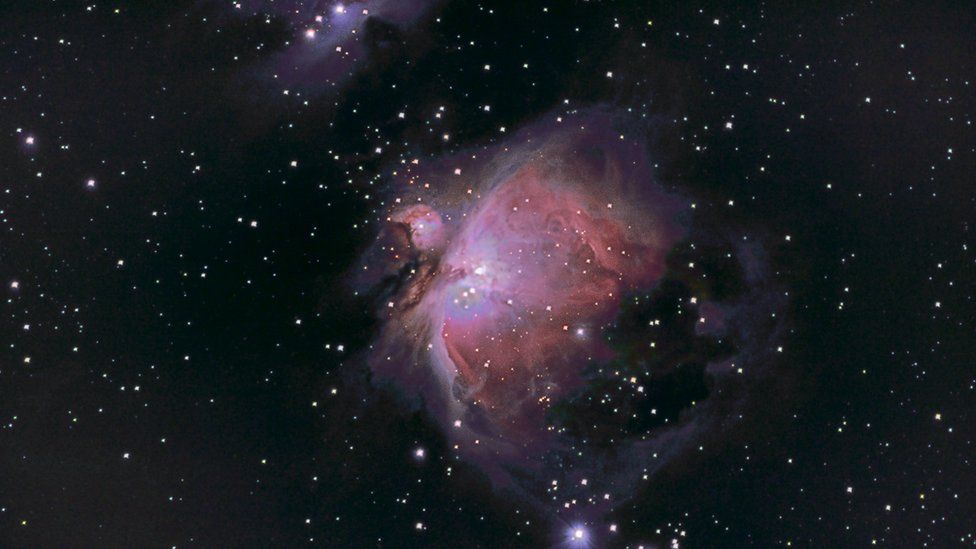
The Orion Nebula captured from Russell Atkin's Sheffield garden
An amateur astronomer has taken "one of his best" photos of the Orion Nebula from his garden during lockdown.
Russell Atkin, from Sheffield, started pointing his camera towards the night sky in 2013, sharing his pictures on social media.
He said it had been an "eight-year learning curve" which saw him travel to Chile before the pandemic.
Covid restrictions have limited Mr Atkin to his garden but his photos continue to impress viewers.
"You can see this with your naked eye, but not in this detail," Mr Atkin said, describing his newest picture of the gas cloud.
"It's the closest region of star birth to Earth and it's about 1,350 light years away."
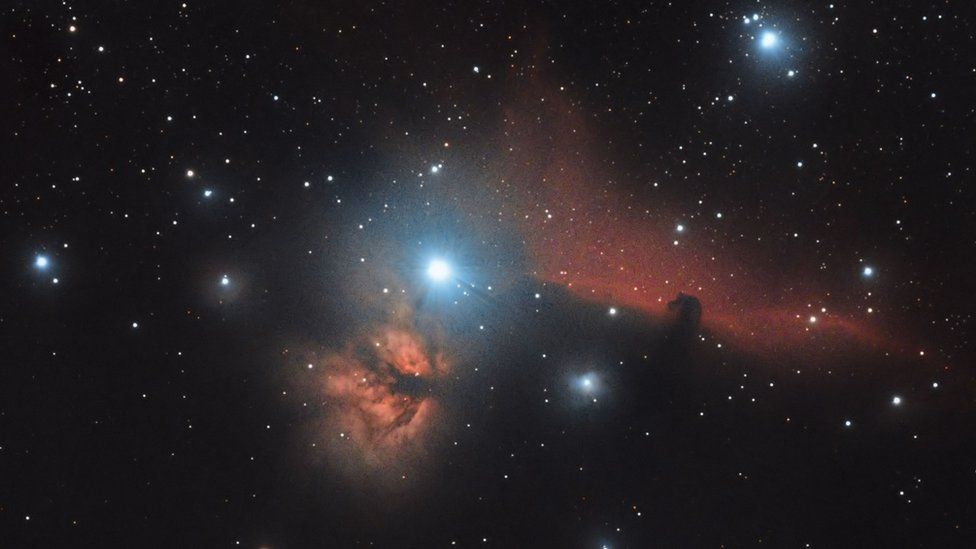
The Horsehead and Flame Nebula, also part of the Orion constellation, seen as a layered picture to "tease" out the detail
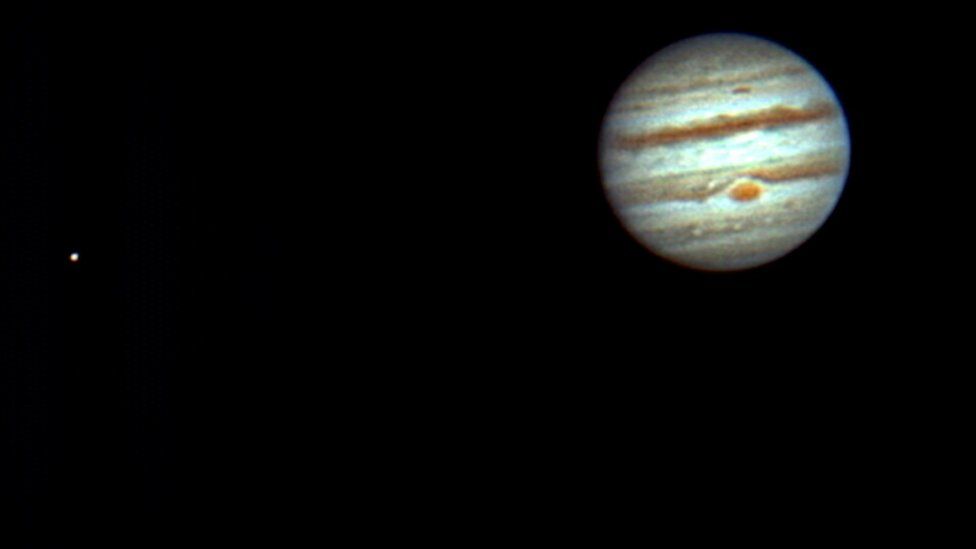
Jupiter and its orbiting moon Europa captured through a telescope
Mr Atkin's photographs capture light that was emitted from stars before William the Conqueror, Joan of Arc and before the Vikings discovered Greenland.
A tracked mount is used to align the stars and galaxies in the centre of the frame, moving the camera against the Earth's rotation to keep it still.
"You need a very, very dark sky to do long exposures," the 52-year-old said. "A few years ago I went out to Chile and I didn't see anything as dark as that before.
"That was about 6,000ft (1,828m) up in the Andes with no light pollution, no pollution, no Moon, so you just get a perfect view of the Milky Way.

The Milky Way captured in the Andes in Chile by Mr Atkin's fellow stargazer Giselle Woodward, also from Sheffield
"In Sheffield, you get lots of stray light, you have to fight against that," he said. "Street lights, light from houses, car headlights and we try and see through all that."
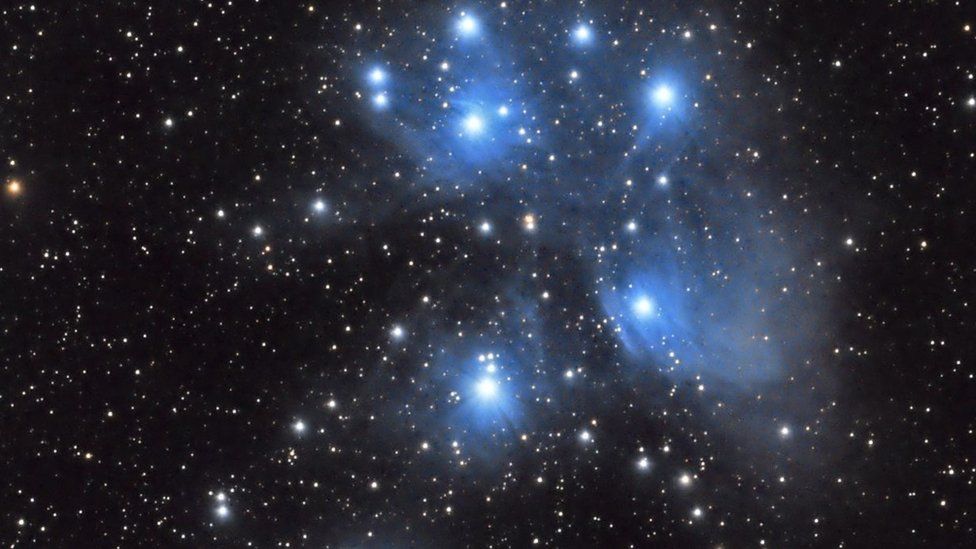
Star cluster Pleiades, also known as the Seven Sisters, as part of the Taurus constellation
His photos have been shared in local Facebook groups, attracting comments from amazed viewers.
"I'm not surprised at the response because these things do wow people," he said.
"I'm a member of the Sheffield Astronomical Society and we do stargazing. When the public come up and look through the telescopes it's like fireworks night - 'Ooh, wow', and the response you get is fantastic."
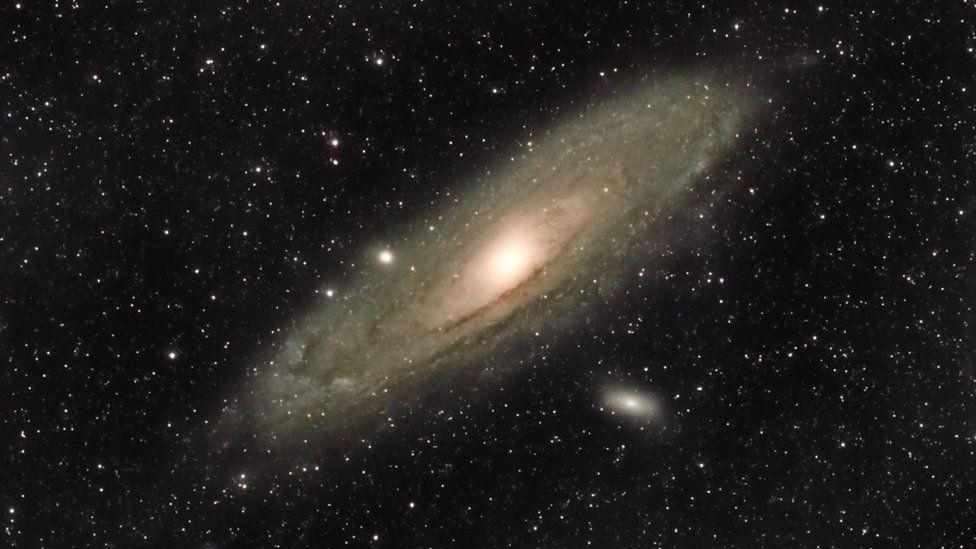
The Andromeda galaxy is the nearest major galaxy to the Milky Way
The final images are made from a number of stacked, long exposure pictures. This helps capture the details of galaxies quadrillions of miles away.
"It's a bit of a dark art to process these," he said. "[One] shot is about 30, two-minute-long shots stacked and aligned to tease out the detail."

Russell Atkin said he's "always looking up", pictured here in front of a telescope
During the pandemic, the astronomical society meetings have moved online but Mr Atkin said he can't wait to invite people back to stargazing nights.
"We're really looking forward to letting them have a look at the jewels of the night sky, because it is a fascinating, fascinating subject."
Pictures copyright Russell Atkin or Giselle Woodward, reproduced with permission.
Stargazer captures night sky from Sheffield garden - BBC News
Researchers discover the mechanism that likely generates huge white dwarf magnetic fields
by Peter Thorley, University of WarwickPhys.org
APRIL 30, 2021
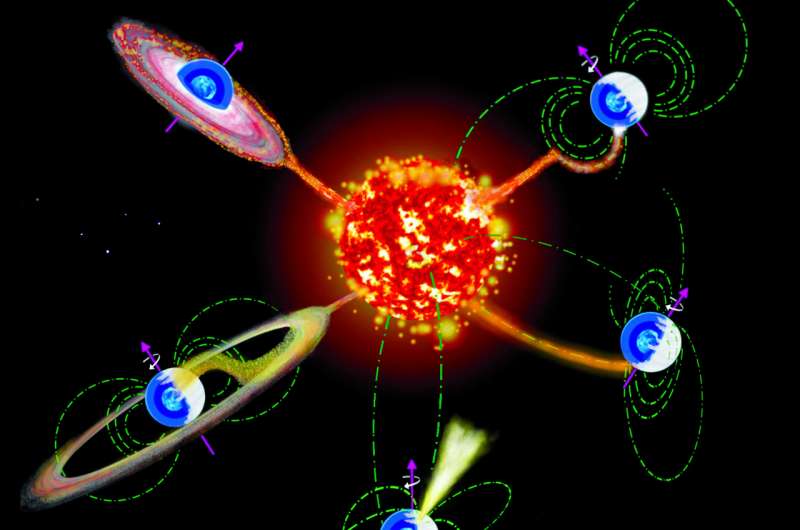
Illustration of the origin of magnetic fields in white dwarfs in close binaries (to be read counter clockwise). The magnetic field appears when a crystallizing white dwarf accretes from a companion star and as a consequence starts to spin rapidly. When the white dwarfs field connects with the field of the secondary star, mass transfer stops for a relatively short period of time. Credit: Paula Zorzi
A dynamo mechanism could explain the incredibly strong magnetic fields in white dwarf stars according to an international team of scientists, including a University of Warwick astronomer.
One of the most striking phenomena in astrophysics is the presence of magnetic fields. Like the Earth, stars and stellar remnants such as white dwarfs have one. It is known that the magnetic fields of white dwarfs can be a million times stronger than that of the Earth. However, their origin has been a mystery since the discovery of the first magnetic white dwarf in the 1970s. Several theories have been proposed, but none of them has been able to explain the different occurrence rates of magnetic white dwarfs, both as individual stars and in different binary star environments.
This uncertainty may be resolved thanks to research by an international team of astrophysicists, including Professor Boris Gänsicke from the University of Warwick and led by Professor Dr. Matthias Schreiber from Núcleo Milenio de Formación Planetaria at Universidad Santa María in Chile. The team showed that a dynamo mechanism similar to the one that generates magnetic fields on Earth and other planets can work in white dwarfs, and produce much stronger fields.
This research, part-funded by the Science and Technology Facilities Council (STFC) and the Leverhulme Trust, has been published in the prestigious scientific journal Nature Astronomy.
Professor Boris Gänsicke of the Department of Physics at the University of Warwick said: "We have known for a long time that there was something missing in our understanding of magnetic fields in white dwarfs, as the statistics derived from the observations simply did not make sense. The idea that, at least in some of these stars, the field is generated by a dynamo can solve this paradox. Some of you may remember dynamos on bicycles: turning a magnet produces electric current. Here, it works the other way around, the motion of material leads to electric currents, which in turn generate the magnetic field."
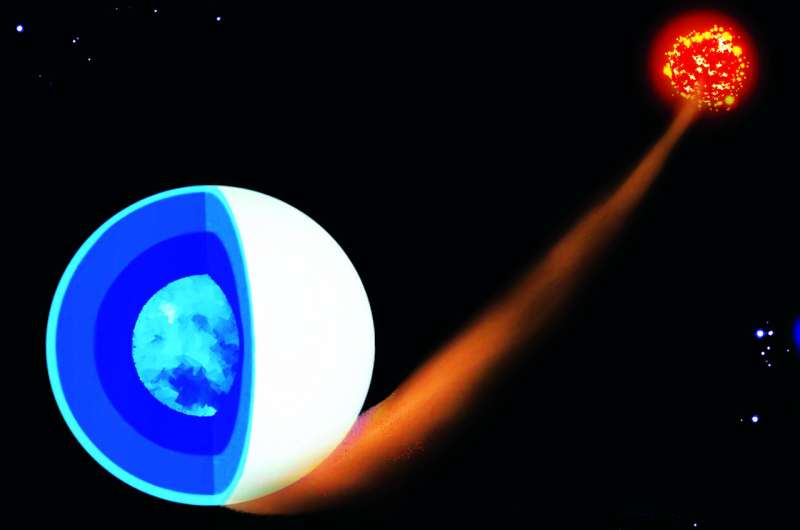
A crystallizing magnetic white dwarf accreting from the wind of its companion star. Credit: Paula Zorzi
According to the proposed dynamo mechanism, the magnetic field is generated by electric currents caused by convective motion in the core of the white dwarf. These convective currents are caused by heat escaping from the solidifying core.
"The main ingredient of the dynamo is a solid core surrounded by a convective mantle—in the case of the Earth, it is a solid iron core surrounded by convective liquid iron. A similar situation occurs in white dwarfs when they have cooled sufficiently," explains Matthias Schreiber.
The astrophysicist explains that at the beginning, after the star has ejected its envelope, the white dwarf is very hot and composed of liquid carbon and oxygen. However, when it has sufficiently cooled, it begins to crystallize in the center and the configuration becomes similar to that of the Earth: a solid core surrounded by a convective liquid. "As the velocities in the liquid can become much higher in white dwarfs than on Earth, the generated fields are potentially much stronger. This dynamo mechanism can explain the occurrence rates of strongly magnetic white dwarfs in many different contexts, and especially those of white dwarfs in binary stars" he says.
Thus, this research could solve a decades-old problem. "The beauty of our idea is that the mechanism of magnetic field generation is the same as in planets. This research explains how magnetic fields are generated in white dwarfs and why these magnetic fields are much stronger than those on Earth. I think it is a good example of how an interdisciplinary team can solve problems that specialists in only one area would have had difficulty with," Schreiber adds.
The next steps in this research, says the astrophysicist, are to perform a more detailed model of the dynamo mechanism and to test observationally the additional predictions of this model.
Researchers discover the mechanism that likely generates huge white dwarf magnetic fields (phys.org)
The USA banned China from the International Space Station.... no problem, we build our own..

